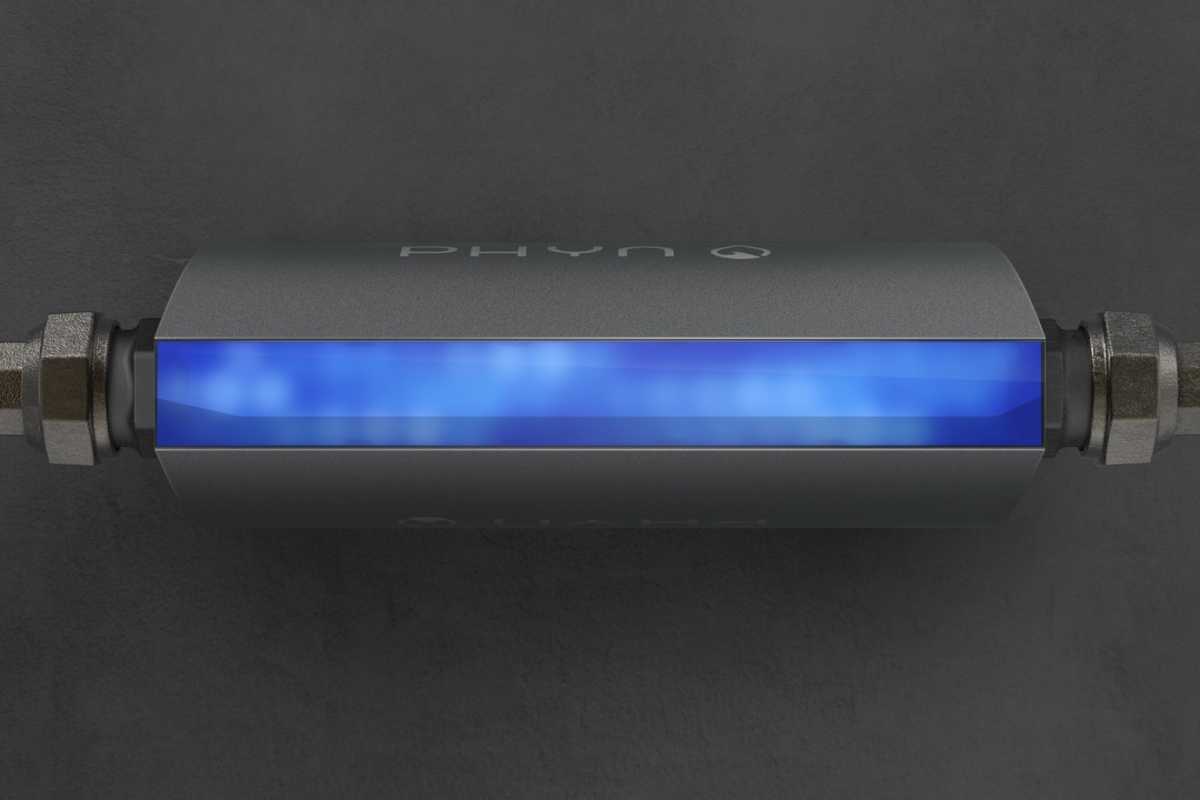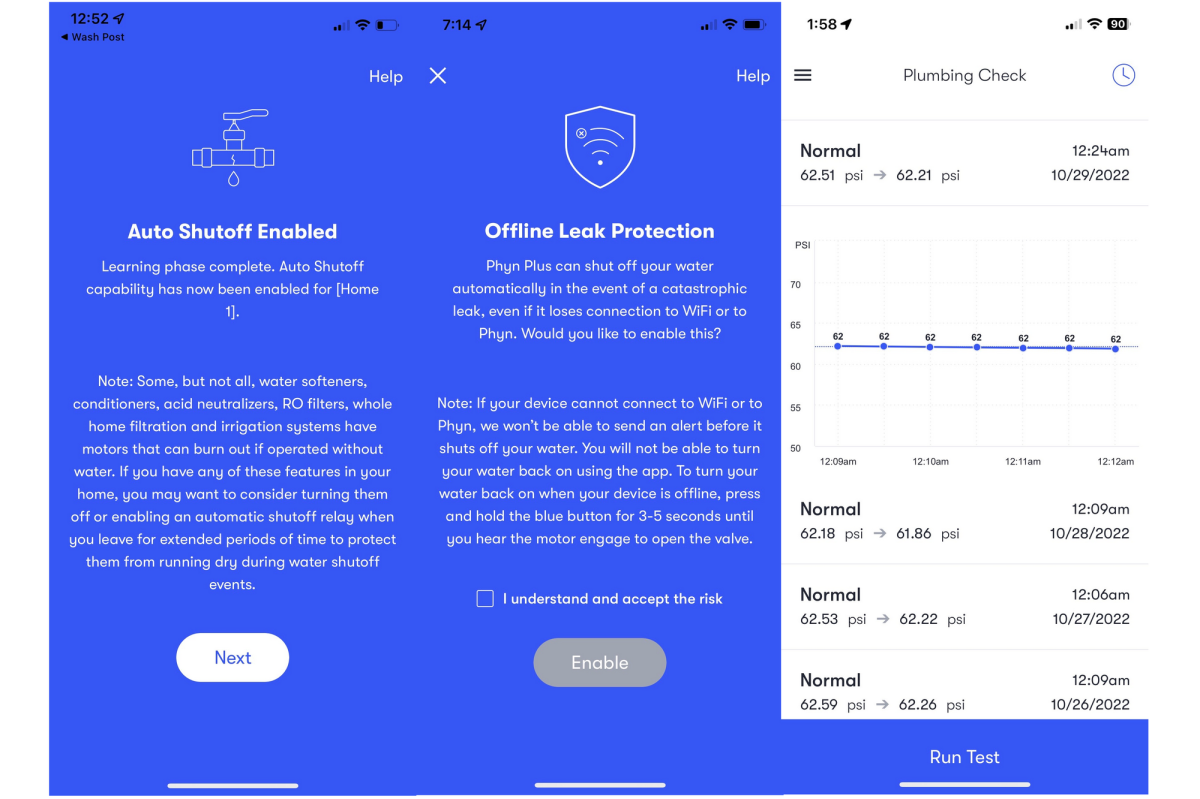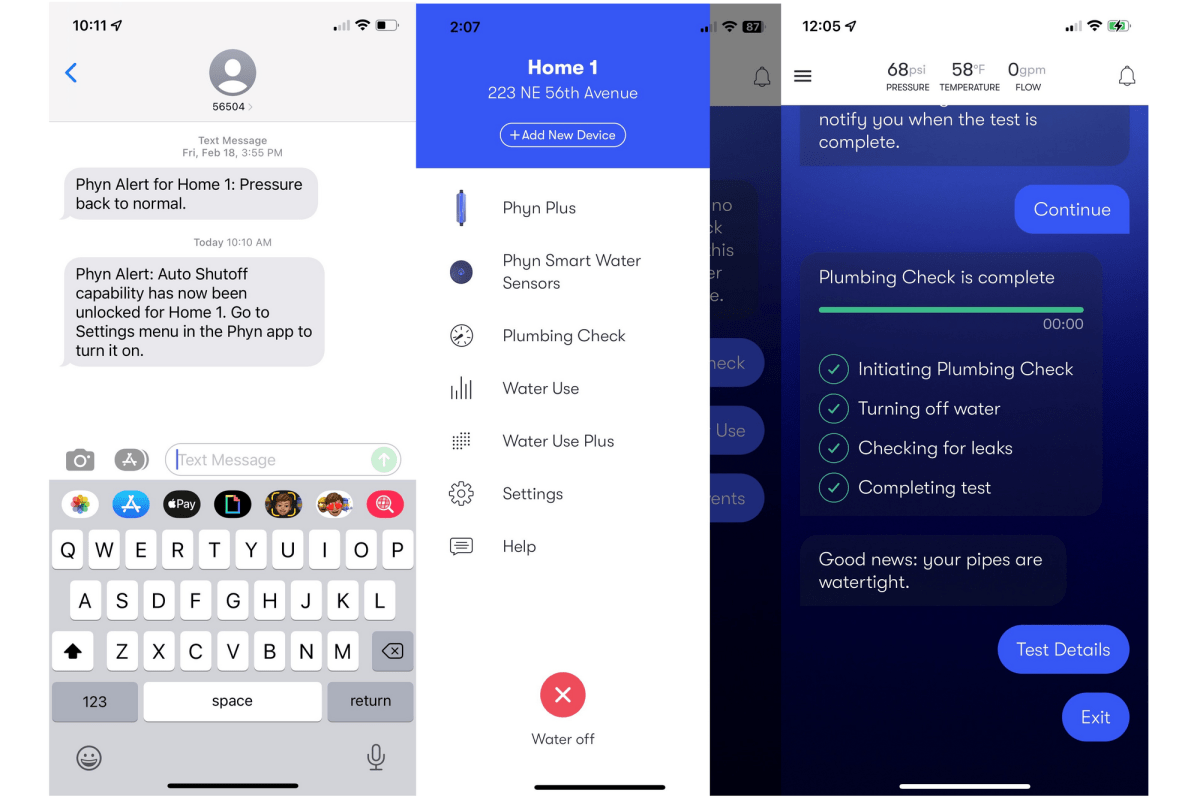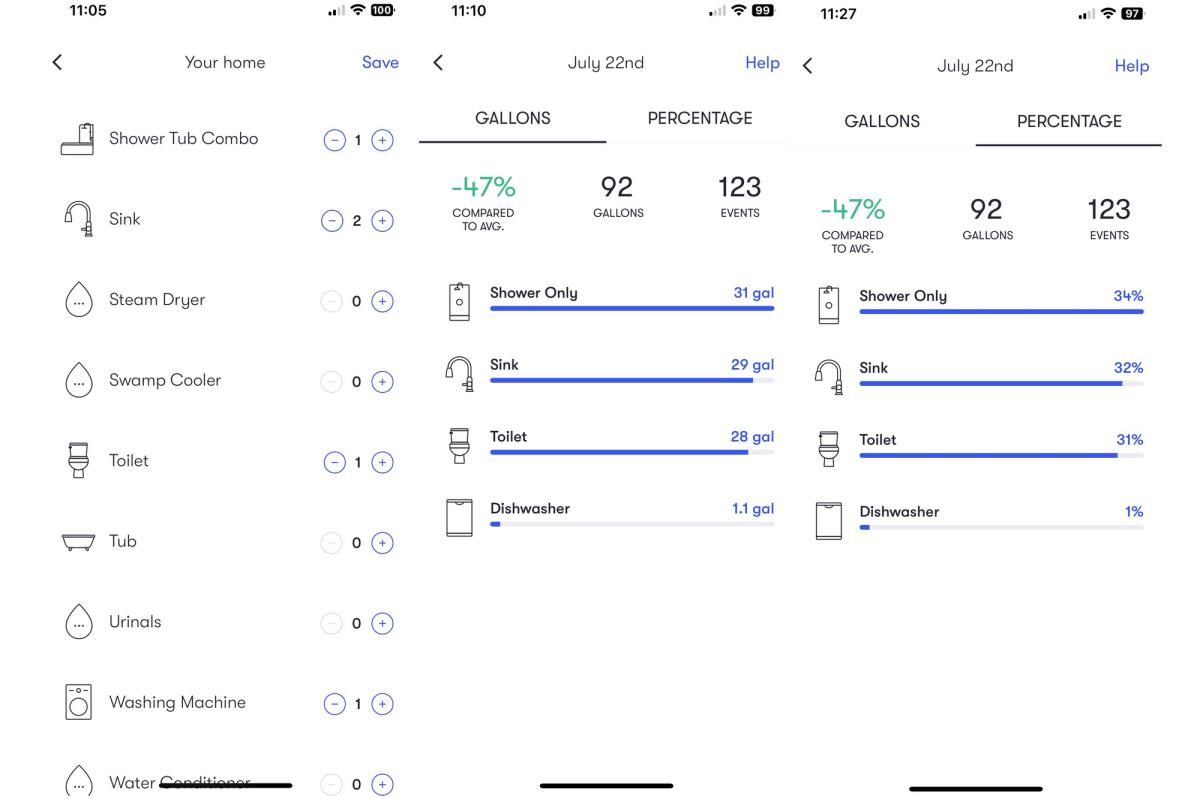At a glance
Expert’s Rating
Pros
- Can prevent catastrophic water damage
- Can work in conjunction with optional stand-alone leak sensors
- Presents detailed analyses of your household water consumption
- Performs automatic daily inspections of your water supply lines
- Compatible with Amazon Alexa, Google Assistant, and IFTTT
Cons
- Best installed by a professional plumber
- Push notifications are easy to overlook
- Can be a pain to connect to your Wi-Fi network
- Not HomeKit compatible
Our Verdict
The second-generation Phyn Plus is incrementally better than the first, but it’s also more expensive. That said, there is no better way to protect your home from catastrophic water damage caused by a plumbing failure, and you might qualify for a discount on your homeowners’ insurance policy if you install one. The Phyn Plus is pricey protection you hope you’ll never need, but catastrophic water damage will cost you many times as much. And even if you never experience a leak, this smart device will inform you of your household’s daily and monthly water consumption, so you can contemplate ways to reduce your use of this precious resource.
Price When Reviewed
$579.00
Best Prices Today: Phyn Plus smart water assistant + shutoff (2nd Gen)
The first-generation Phyn Plus impressed us with both its ability to detect leaks in your home’s water supply and its real-time water-use analysis. This second-generation product has increased in price, but it’s also incrementally better—although not enough to justify upgrading if you already have one installed.
The Phyn Plus (2nd Gen)—I’ll just call it the Phyn Plus from here—gets installed inline of your main water supply from your utility—or your well, as the case may be—so installation is best left to a professional plumber. The valve has 1-inch male NPSM fittings at each end, so you might need adapters. Phyn paid a plumber to install the Phyn Plus (2nd Gen) on the PEX supply line in my basement for this review (you can see it installed in the photo up top).
This review is part of TechHive’s in-depth coverage of the best smart water leak detectors.

The Phyn Plus puts on quite the light show, but you might never see it.
Phyn LLC
The Phyn Plus is fully weatherized and can be installed indoors or out, but you will need to have an AC outlet within 15 feet of the installation location, because there is no battery-power option. In fact, you might want to plug the unit into an uninterruptible power supply to eliminate the risk of a power outage preventing it from doing its job.
The plumbing fixture manufacturer Kohler offers a professionally installed private-label version of the Phyn Plus—the Kohler H2Wise+ Powered by Phyn—and the two companies recently announced a collaboration with the smart home service provider Alarm.com that integrates both Phyn’s and Kohler’s smart water valves into its professionally monitored smart home platform. Alarm.com provides back-end services for many independent smart home and home security service providers.
Note: The Phyn Plus isn’t much to look at once it’s installed, so most of the visual assets in this review will be screenshots of the Phyn app.
Setting up the Phyn Plus

You’ll need to let the Phyn Plus evaluate your water supply system for a few days before it turns on its auto-shutoff feature. You also have the option to enable it to automatically shut off your water supply if it suspects there’s a significant water leak, but it can’t connect to your Wi-Fi network to warn you first.
Michael Brown/Foundry
Once the Phyn Plus is installed, you’ve set up the Phyn app on your mobile device, and then added the valve to your Wi-Fi network, it will begin analyzing your water consumption. A quick note on setup: The Phyn Plus will only connect to a 2.4GHz Wi-Fi network and that step gave me trouble.
I use a Ring Alarm Pro, which has an integrated Eero dual-band mesh router, and the smart valve wouldn’t join my Wi-Fi network until I gave the router’s 5GHz network a name distinct from its 2.4GHz network. I also had to type in the Wi-Fi password—the Phyn app doesn’t allow you to copy and paste this text—which is just dumb. With that step accomplished, I was able to restore my 5GHz network’s original name (the same name as the 2.4GHz network), so that the router’s band-steering function can work as it should, automatically directing dual-band network clients to the least-congested frequency band.

You can open and close the Phyn Plus smart valve from within the app. That’s a great feature at my house, since I would otherwise need to go the curb, where my water meter is located, to shut off my main water supply.
Michael Brown/Foundry
With my set-up hurdle out of the way, the ultrasonic sensors inside the Phyn Plus immediately began testing my water pipes for leaks: It shut off my main water supply and then waited to see if it detected a drop in water pressure that would indicate a leak (the device measures water pressure in the pipe several hundred times each second). This test repeats every day at a time when you’re not typically using water, so it doesn’t report a false positive. In my household, the test usually runs shortly after midnight.
Since the valve measures your home’s water pressure, it revealed a serious problem with my water supply: The water coming into my house from the public utility was much too high—96 psi (pounds per square inch). Most of the time, people complain their water pressure being too low, which can lead to a poor shower experience. But excessively high water pressure will strain not only your water pipes but also all the valves and fixtures (your faucets and toilets, for instance) in your home as well as the hoses connected to appliances such as your washing machine and dishwasher.

Provide an inventory of your water-related fixtures and appliances and the Phyn Plus will report how much water they’re using each day.
Michael Brown/Foundry
In fact, our bathroom faucet started leaking shortly after we moved into the home, and I had to replace it. I had assumed the seller installed a cheap faucet during a recent remodel, but the 96-psi water pressure was the more likely culprit. We had the plumber come back a few days later and install a pressure reducer on the incoming water supply, ahead of the Phyn valve. That was an expensive job, but it would have been just a matter of time before the high water pressure caused a water pipe to burst or resulted in a damaged fixture or appliance. Today, the home’s water pressure stays right around 62 psi.
In addition to real-time water pressure readings, the Phyn Plus’s sensors also measure water temperature and—if water is being used anywhere in the house—how fast that water is flowing (in gallons per minute). This information is uploaded to the cloud for real-time analysis, where an algorithm can also determine the most likely sources of the flow: a toilet flushing, a dishwasher operating, someone filling a bathtub or taking a shower, an outdoor spigot being used to water the garden, and so on. You can help the algorithm identify your water-consuming fixtures by filling out an inventory in the Phyn app.

After the Phyn Plus warned that the water pressure on my incoming supply line was much too high, I hired a plumber to install a pressure-reducing valve to lower it to a more reasonable level.
Michael Brown/Foundry
How the Phyn Plus prevents burst pipes
If the water temperature gets too low, indicating the possibility that a pipe might freeze, the Phyn Plus can shut off your water supply, so you don’t need to worry about catastrophic water leak from a burst pipe. I experienced this problem at my previous home while we were out of town one weekend. A copper pipe in my garage froze and burst, resulting in nearly $30,000 in damage because the water flowed from the pipe for several days. The Phyn algorithm can also identify unusual flow patterns, such as a leaky faucet or a worn-out flapper that causes a toilet to refill its tank more often than it should, and it will warn you about these events with a push notification to the Phyn app as well as a text message.
This is one area in which Phyn’s biggest competitor—the Flo by Moen Smart Water Monitor & Shutoff—has the better approach: Moen will initiate a robocall when it suspects there’s an uncontrolled water flow that could cause damage. Robocalls are much harder to ignore than push notifications and text messages. Should water flow indicate a bigger problem, such as a broken hose or pipe, both the Phyn and the Flo by Moen will warn you and then automatically shut off your water supply to prevent worse damage if you don’t take action yourself.
Using a Phyn Plus with Alexa or Google Assistant
If you’re home and you spot a big water leak yourself, you don’t need to wait for the Phyn Plus to analyze the problem and then take action. You can turn the valve off yourself with the touch of a button in the Phyn Plus app, or (if you have an Alexa or Google Home smart speaker) you can ask Alexa or Google Assistant to tell Phyn to shut off your water supply (and to turn it back on). The Phyn Plus also supports IFTTT, so you can have third-party devices trigger the valve to close. By the same token, events logged in the Phyn app can trigger other devices to perform an action. For example, you can set up an IFTTT applet to flash your smart lights if Phyn Plus detects a water leak. There is currently, however, no support for Apple’s HomeKit ecosystem.
The Phyn Plus will react even faster if you place Phyn Smart Water Sensors in places susceptible to water leaks; good spots might include under your sink, next to your water heater, or beside a dishwasher, washing machine, or toilet (you can deploy up to nine of the devices). These 3.5-inch pucks are equipped with contact sensors that will detect the presence of water where it shouldn’t be, and you’ll get an immediate warning if it does. Phyn sells optional accessories—a 48-inch cable with a 1-inch disc-shaped sensor at the end, and 48-inch cable with a female connector at its end, so you can daisy-chain up to three of those cables—that extends the sensor’s reach. The latter cable is water sensitive across its entire length—up to 12 feet with three cables plugged into each other.
When triggered, Phyn Smart Water Sensors will send a similar warning to your smartphone, where you’ll have the option to send a command to the Phyn Plus to shut down your water supply. These sensors also monitor the ambient temperature and relative humidity where they’re placed, warning if the air get too moist (presenting a risk of mold or mildew) or too dry (making you susceptible to nosebleeds and other ailments). It’s worth noting, however, that these remote sensors have the same limitation when it comes to Wi-Fi connectivity; namely, they will only connect to your 2.4GHz Wi-Fi network.
Phyn Plus provides water-use analysis
As I’ve already mentioned, the Phyn Plus will identify where water is flowing in your home in real time, and it can report precisely how much water each device has consumed over time—with at least some degree of accuracy.
This feature was in beta when I reviewed the original Phyn Plus, and I still wouldn’t say it’s 100 percent perfect in identifying the source. The more feedback you provide via the app, however, the more accurate the identification becomes. Phyn’s sensors analyze the flow of water passing through the valve and Phyn’s algorithm does its best to identify a unique signature from each source. If it gets it wrong—identifying a flow as coming from your shower when in fact it was the outdoor spigot—you can correct it and it will learn from that information and do better the next time.
Phyn’s app will also compare your home’s water use against that of an average same-sized household. My wife and I put in new landscaping in our front and back yards—shrubs and trees, but no thirsty lawn—and despite Portland’s rainy season coming very late this year, I’m happy to report that our water usage over the past eight months is slightly lower—by 4.25 percent—than what Phyn thinks is average for a two-person household.

The Phyn app will display an animation (left) when water is running anywhere in your home. The app will also track your household water consumption (middle) and compare your useage to the typical household of the same size (based on the number of people living in your home).
Michael Brown/Foundry
Is the Phyn Plus (2nd Generation) worth $579?
The Phyn Plus smart valve is expensive, there’s no getting around that. But it’s a bargain compared to the cost of recovering from a catastrophic water leak, and those don’t necessarily happen in a manner that’s immediately noticeable. Over time, a slow leak inside a wall can do more damage than a pipe in plain view that suddenly fails. The Phyn Plus will limit the damage in either scenario.
Even if you’re fortunate enough to never experience a water leak—however unlikely that might be—the Phyn Plus is useful for analyzing your home’s water use and considering ways to use it more effectively. That will save you money and help you reduce your impact on the environment.

